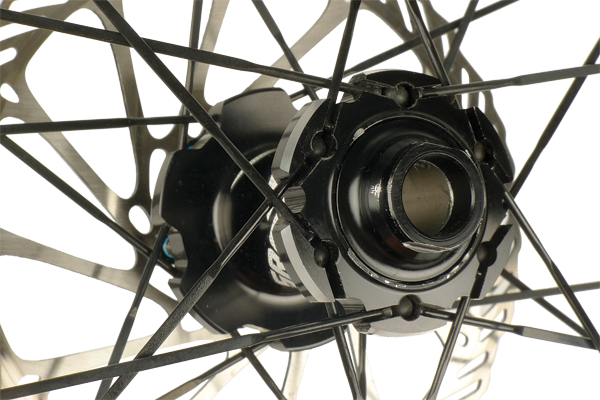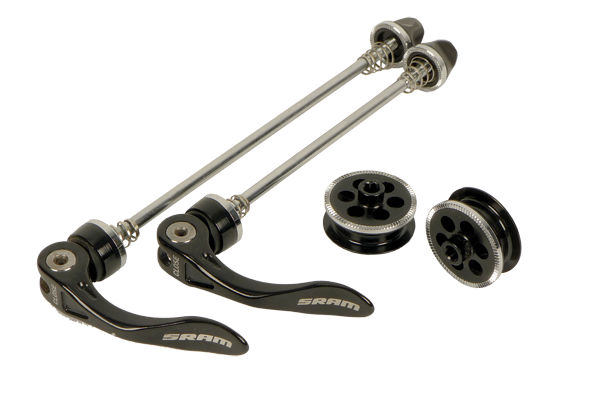SRAM Rise 40 Wheels
 Given that they already make most other MTBcomponents, it’s a logical step forSRAMto start making full wheelsets (not to mention the fact that they own road wheel brand Zipp). So the advent of the mid-priced Rise 40 (and the top-end, carbon rimmed Rise 60) wheels should come as no surprise. The Rise 40s are available for either 26 or 29-inch bikes, and are intended as an all-purpose option for everything from the occasional XC race through to a bit of light all-mountain riding. They’re available with either 15mm or traditional quick release front hubs, and 142x12mm or traditional rear hubs.
Given that they already make most other MTBcomponents, it’s a logical step forSRAMto start making full wheelsets (not to mention the fact that they own road wheel brand Zipp). So the advent of the mid-priced Rise 40 (and the top-end, carbon rimmed Rise 60) wheels should come as no surprise. The Rise 40s are available for either 26 or 29-inch bikes, and are intended as an all-purpose option for everything from the occasional XC race through to a bit of light all-mountain riding. They’re available with either 15mm or traditional quick release front hubs, and 142x12mm or traditional rear hubs.
SRAMoffers a claimed weight of 1,710g per set but our 15mm front/quick release rear wheelset actually came in at 1,821g including the supplied rim tape (778g front and 1,043g rear). With an inner rim width of 19mm they’ll offer enough support for tyres up to around 2.3 inches wide, and their retail price of $620 makes them quite affordable by aftermarket wheel standards.

The R&D team atSRAMhave been working on these wheels for over two years, and there are some nice details as a result. Firstly, the rims have an asymmetric design with the spoke bed noticeably offset to one side. This compensates for the offset created in the hubs by the freehub on the rear and the disc rotor on the front. The result is more symmetrical spoke tension and more symmetry theoretically means stronger, more durable wheels. Taking this a step further, the newly designed hub shells have different flange sizes on either side to further even out the spoke length and tension. Our test wheels were impressively even and tight out of the box—it’s nice to see well-built wheels at this comparatively affordable price.
Bladed straight pull spokes (24 per wheel) feed into the flanges from the outside, which should make them quicker and easier to replace should the need ever arise (no pun intended). If you run a traditional quick release up front, the Rise 40s feature oversized end caps to stiffen the fork up and improve steering accuracy.

Finally, the decals are screen printed rather than just being stuck on so their finish should be very durable, and in our opinion the gloss black finish looks great. The flip side is that the screened graphics mean there’s no option to remove them for those who love the stealth look.
Rise & Fall
Despite these nice details, the Rise 40 wheels fall short in a couple of key areas, both at the rim and the hub. For starters, you’ll need to fit Stan’s-style rubber rim strips if you want to use them without inner tubes. Many $600-700 wheels are found wanting in this area, but there are also a good number that do feature tubeless compatibility without adding rubber conversion strips. Given these wheels are a brand new addition to the market, it’s surprising that this wasn’t factored in. Rubber rim strips will add 120g to the wheelset, taking their effective weight up over 1,900g—around 100-150g heavier than comparably priced tubeless ready wheels.

Like most wheels in this price bracket, the front hub is convertible between quick release and 15mm thru-axle but the rear is not. With thru-axles rapidly taking over on some new bikes but many riders still on bikes with quick release drop-outs, it presents a dilemma of whether to buy wheels to match your current rig, or wait to get a new bike before looking at wheels.
The rear hub’s pawl mechanism also features the slowest pickup of any hub we’ve seen; it only engages every 24 degrees (15 points per revolution). Even the cheapest hubs from other brands use at least 18 points of engagement, and many now use around 30 or more. Whilst this may not be an issue when you’re riding along at a constant cadence, it means there’s a lot of ‘dead spin’ at the pedals when you’re in more technical situations like climbing through rough terrain.

SRAMare obviously aware of the significance of these two issues, as the Rise 60s use completely different hubs. Both are easily converted between axle standards the rear hub engages every 6.7 degrees (54 points). It’s just unfortunate that you have to spend $2,300 on their top-flight carbon wheels to gain these features—and even they still require a conversion kit for tubeless use. PerhapsSRAMwould have been better served by offering the Rise 60 hubs with the lower priced alloy rim from the Rise 40 as a ‘meet in the middle’ kind of solution. Finally, servicing the Rise 40 rear hub requires three different-sized cone spanners, even though there are only four nuts involved; surely this could have been simplified?
After a few months of being subjected to general trail use on a 140mm bike the front wheel was still running true, but the rear had a couple of wobbles as well as three decent sized dents in the bead hook—while this is a little more trail damage than we’d typically expect, it could just be bad luck. Their stiffness, build quality and finish may be great, especially at this price point, but it’s unfortunate that they fall short in a few key areas.
Monza Bicycle (03) 8327 8080 / www.sram.com


 Given that they already make most other MTBcomponents, it’s a logical step forSRAMto start making full wheelsets (not to mention the fact that they own road wheel brand Zipp). So the advent of the mid-priced Rise 40 (and the top-end, carbon rimmed Rise 60) wheels should come as no surprise. The Rise 40s are available for either 26 or 29-inch bikes, and are intended as an all-purpose option for everything from the occasional XC race through to a bit of light all-mountain riding. They’re available with either 15mm or traditional quick release front hubs, and 142x12mm or traditional rear hubs.
Given that they already make most other MTBcomponents, it’s a logical step forSRAMto start making full wheelsets (not to mention the fact that they own road wheel brand Zipp). So the advent of the mid-priced Rise 40 (and the top-end, carbon rimmed Rise 60) wheels should come as no surprise. The Rise 40s are available for either 26 or 29-inch bikes, and are intended as an all-purpose option for everything from the occasional XC race through to a bit of light all-mountain riding. They’re available with either 15mm or traditional quick release front hubs, and 142x12mm or traditional rear hubs.

